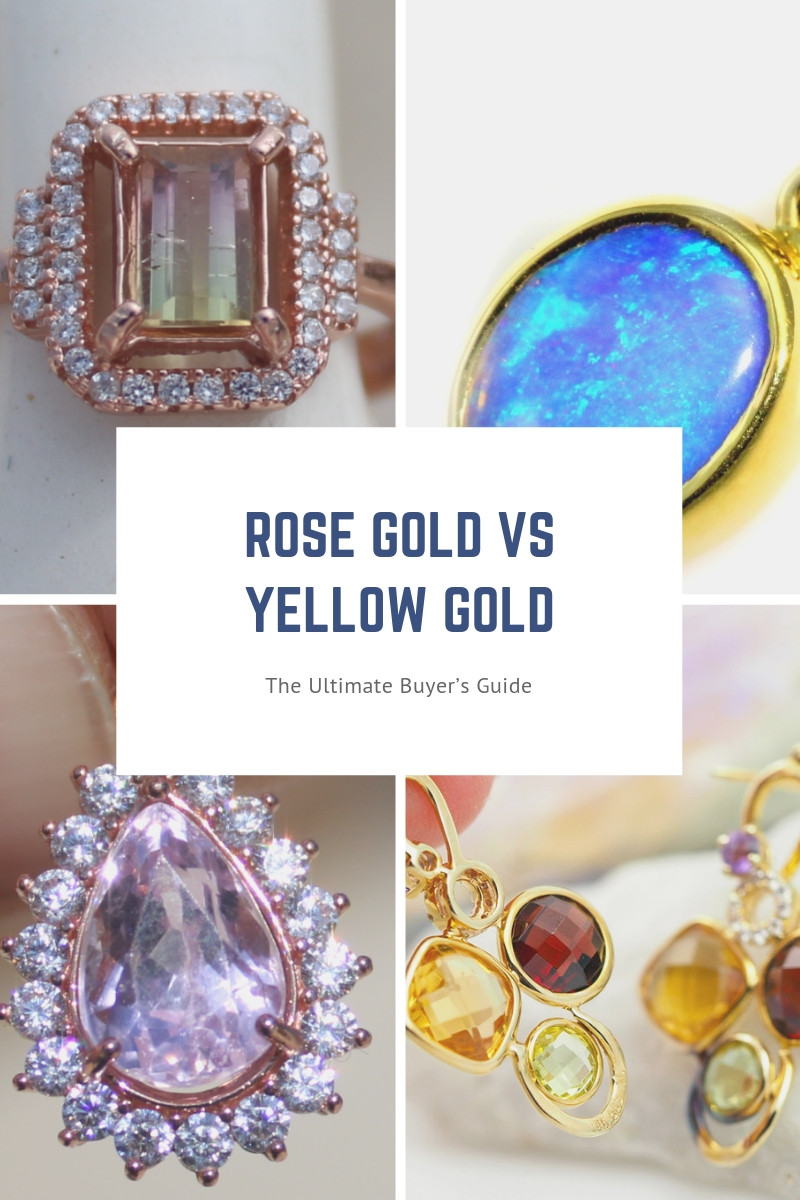
ローズゴールド vs イエローゴールド - 究極の購入者ガイド
 スタイルトレンドを追っている人なら、ローズゴールドと呼ばれるファッション現象に気付いたことがあるでしょう。ローズゴールドがジュエリーの世界でスタイリッシュな力として登場して以来、激動が起こり、さまざまな市場に浸透して、あらゆるものがローズゴールドで販売されています。ローズゴールドの婚約指輪からキーホルダー、時計、テクノロジーアクセサリーまで、ローズゴールドは新しい「イット」ファッショントレンドです。
スタイルトレンドを追っている人なら、ローズゴールドと呼ばれるファッション現象に気付いたことがあるでしょう。ローズゴールドがジュエリーの世界でスタイリッシュな力として登場して以来、激動が起こり、さまざまな市場に浸透して、あらゆるものがローズゴールドで販売されています。ローズゴールドの婚約指輪からキーホルダー、時計、テクノロジーアクセサリーまで、ローズゴールドは新しい「イット」ファッショントレンドです。
ローズ ゴールドは従来のイエロー ゴールドよりも優れているのでしょうか? ローズ ゴールドは流行遅れになるのは避けられない流行なのでしょうか? ローズ ゴールドはイエロー ゴールドよりも高価ですか?
答えは白か黒か、あるいはローズかイエローかという単純なものではありません。しかし、中間のどこかで、ローズゴールドとイエローゴールドにはそれぞれ長所と短所があります。
ローズゴールドとイエローゴールドを比較する購入ガイドを読んで、知っておくべきすべてのことを学びましょう。
一番良い点は、ローズ ゴールドとイエロー ゴールドの両方のメリットと落とし穴を包括的に理解できることです。この知識があれば、ローズ ゴールド、イエロー ゴールド、またはその両方を購入するかどうかについて、情報に基づいた決定を下すことができます。
金の自然な色は何ですか?
天然の金は、その通り、黄色です。ローズゴールドは、実は自然の産物ではなく、特徴的なバラ色の色合いを得るために、複数の金属を混ぜて加工したものです。
実際、金はローズゴールドやホワイトゴールドなど、さまざまな色に変えることができます。純金だけではやや柔らかく、ジュエリーに使用するには硬さが足りません。毎日身につけるジュエリーは必然的に酷使されやすいため、変色せずに形を保つには、金をより硬い形に加工する必要があります。
それはどのように起こるのでしょうか? 純金の強度を高めるには、他の金属と混ぜて合金と呼ばれるものにする必要があります。

合金について
銀、銅、亜鉛を純金と混ぜて金属合金を作ります。このプロセスにより、より耐久性があり、強く、長持ちする金が生まれます。同様に、金のジュエリーのカラット数は、混合物に使用されている純金の量に関係します。たとえば、14K または 18K の金は金の純度が高くなりますが、合金の含有量も少なくなるため、耐久性は低くなります。
逆に、10K ゴールドには合金が多く含まれているため、耐久性が高くなります。
では、ローズゴールドの耐久性はどうでしょうか?
ローズ ゴールドは、魅力的なバラ色の色合いを生み出すユニークな金属の組み合わせです。最も人気のあるローズ ゴールドの比率は、純金 75 パーセント、銅 22.5 パーセント、銀少々です。
ローズ ゴールドはこのようにして、あの美しいピンクの色合いをしています。ローズ ゴールドにはさまざまな色があり、より明るい色や暗い色のローズ ゴールドのジュエリーも用意されています。イエロー ゴールドと同様に、ローズ ゴールドの色合いは、混合物に使用されている純金の量によって決まります。
ローズゴールドとイエローゴールド:低アレルギー性ですか?
イエローゴールドとローズゴールドでは、イエローゴールドの方が低アレルギー性です。基本的には、両方の金属に使用されている合金に起因します。
ローズゴールドの金属合金には、私たちがよく知っていて愛しているあの赤みがかった色合いを出すために銅が含まれている必要があります。残念ながら、銅は敏感肌にとってアレルギー物質です。銅に敏感な方は、ローズゴールドのジュエリーの購入は避けた方が良いでしょう。
イエロー ゴールドには、別の金属アレルゲンであるニッケルを含むことがある金属合金も含まれています。ただし、イエロー ゴールドでは、銅やニッケルを使用しない合金混合物を購入するオプションがあります。また、カラット数が高い金には、アレルギー反応を引き起こす可能性のある合金が少なくなります。
結局のところ、イエローゴールドは 2 つのうち最も低アレルギー性です。 
ローズゴールドとイエローゴールドの歴史と現代の人気
イエロー ゴールドは時代遅れでしょうか? イエロー ゴールドが 90 年代半ばに急激に流行遅れになったことを覚えているかもしれません。実際、イエロー ゴールドは古臭く、安っぽく、全体的に時代遅れだと考えられていたため、ホワイト ゴールドとシルバーが主役になりました。
痛い。
今、イエロー ゴールドが再び流行しています。イエロー ゴールドは影に隠れ、再び脚光を浴びていますが、何千年もの間愛されてきた金属です。実際、イエロー ゴールドは歴史があり伝統的な結婚指輪です。控えめながらもエレガントなイエロー ゴールドの結婚指輪をはめている両親や祖父母はいますか? 結論: イエロー ゴールドは流行しており、非常に人気があります。
実際、それは何千年も続いています。
金の歴史は紀元前 4 万年の旧石器時代にまで遡り、文字通り歴史の記録そのものと同じくらい歴史があります。古代エジプトでファラオの地層に金が組み込まれるまで、金は通貨交換の手段としては利用されず、最終的には地位、富、装飾の象徴となりました。
数世紀後、米国議会は金を固定価格通貨として公式に割り当てました。19 世紀にはゴールド ラッシュが相次ぎ、金は経済活動となりました。
歴史は、イエローゴールドが昔から愛されている金属であることを証明しています。金自体も流行遅れになることはありますが、おそらく常に時代遅れではなく、関連性のある金属であり続けるでしょう。
では、ローズゴールドは人気のスケールでどこに位置するのでしょうか。ローズゴールドがジュエリー業界を席巻していることは否定できません。近年の急激な人気上昇を考えると、ローズゴールドが新参者だと勘違いするのは当然です。ローズゴールドは流行っているのでしょうか。もちろんです。しかし、ローズゴールドの歴史は帝政ロシアで普及した1800年代にまで遡ります。実際、ローズゴールドの最初の名前は「ロシアンゴールド」でした。とはいえ、ローズゴールドの歴史はイエローゴールドよりも不安定で、1920年代の豪華な時代のような大きなピークを迎えた後、アールヌーボー時代にホワイトゴールドとシルバーに取って代わられました。
ローズゴールドは急上昇しているようで、沈静化しているようですが、現在の地位に異論はありません。ローズゴールドの人気が山のように高まっていることは周知の事実であり、これが次のポイントにつながります。
ローズゴールドやイエローゴールドは流行遅れになるでしょうか?
90 年代にイエロー ゴールドに何が起こったかはすでに知られていますが、ゴールドが一度流行から消えた後にこれほど執拗に復活したのは驚くべきことだとだけ言っておきましょう。
一夜にして市場を席巻したファッショントレンドは、あっという間に流行遅れになる可能性もあります。シャグカーペットやパラシュートパンツを覚えていますか? とにかく、この話題について考えてみましょう。
ローズゴールドは新しいトレンドですよね?そこで疑問が湧きます。すべてのトレンドには有効期限があるのでしょうか?10年後には流行遅れになるかもしれないローズゴールドの婚約指輪を買うのはリスクがあるのでしょうか?
流行の予測はできませんが、経験則としては、気に入ったものを買うことです。ローズゴールドの婚約指輪に夢中になっていて、他の金属を着けるのは考えられないという場合は、ぜひ購入してください。流行遅れになっても気にしません。大切なのは、自分がそれを気に入っているかどうかです。
結局のところ、どんな高級ジュエリーを買うにしても、流行遅れになるリスクはあります。イエロー ゴールドを例に考えてみましょう。何世紀にもわたり、イエロー ゴールドは婚約指輪の主流でした。90 年代に流行遅れになったとき、誰もがゴールドの指輪を捨てたでしょうか? いいえ。ご存知のとおり、ゴールドは再び人気が復活し、今や再び大人気です。
スタイルのトレンドを認識することは重要ですが、もっと大切なのは、自分の心に響くジュエリーを選ぶことです。その絆で、トレンドの山も谷も乗り越えましょう。私たちが学んだことの一つは、トレンドは盛衰しますが、結局のところ、金属に関係なく、時代を超えたジュエリーは常に流行しているということです。
肌の色: ローズゴールド vs イエローゴールド
ジュエリーを選ぶときは、どの色と金属が自分の肌の色に最も合うかを考慮する必要があります。金属によっては、特定の肌タイプや肌の色調に美しくマッチしますが、色あせて見えるものもあります。
ローズゴールドはどんな肌の色にも美しく映えます。赤みの色合いを優雅に強調し、金色、日焼け、黒い肌に神秘的な輝きを加えます。
イエローゴールドは、オリーブ色や黒っぽい肌など、暖色系の肌色によく映えます。しかし、青白い肌色や寒色系の肌色には強すぎるため、平坦で色褪せた印象を与えることがあります。
どれが自分の肌に一番合うかはどうすればわかりますか? 実際には、それぞれ試してみて、どれが自分の肌の色に一番合うか確認するのが一番です。 
イエローゴールドとローズゴールドの耐久性
ジュエリーを毎日着用する予定なら、摩耗に耐えられるほど耐久性があることを確認する必要があります。イエロー ゴールドとローズ ゴールドではどちらがより耐久性がありますか?
結論: ローズ ゴールド。なぜでしょうか? 金属混合物に銅が組み込まれているため、ローズ ゴールドは非常に耐久性があります。そのため、ローズ ゴールドは、長期間使用した場合に避けられない傷を除いて、良好な状態を保つために特別な手入れは必要ありません。ローズ ゴールドは変色しますか? 簡単には変色しません。
一方、イエローゴールドは形が崩れやすく、傷や擦れがつきやすいです。 イエローゴールドの純度が高いため、その輝きを保つには定期的な研磨が必要です。
ご覧のとおり、ローズゴールドはイエローゴールドよりも耐久性があり、日常使いに最適です。とはいえ、イエローゴールドも優れた選択肢ですが、新品同様の状態を保つにはより多くの手入れとメンテナンスが必要です。
ローズゴールドとイエローゴールドにはロジウムメッキが必要ですか?
ホワイトゴールドを中心に、一部のゴールドには、金属の耐久性と強度を高めるためにロジウムメッキが必要です。しかし、ローズゴールドは銅合金のため耐久性に優れています。つまり、ローズゴールドは強化のためにメッキする必要がなく、色が簡単に変色しません。
イエローゴールドは、白色に変色させて保護層を追加するためだけにロジウムメッキが施されています。ただし、ロジウムメッキのゴールドジュエリーは、時間が経つとメッキが剥がれ、下にある黄色が浸透し、再メッキが必要になるため、必ずしも推奨されるわけではありません。
ローズゴールドとイエローゴールドの手頃な価格
ローズゴールドとイエローゴールドの価格を比較すると、かなり公平な市場であることがわかります。もちろん、ダイヤモンドや宝石などの装飾は個々の作品の価格を引き上げます。しかし、ローズゴールドとイエローゴールドの単純な価値はほぼ同等です。
イエロー ゴールドとローズ ゴールドはどちらも金が主成分なので、価値と価格はカラット数に関係します。たとえば、18K ゴールドは 12K や 14K ゴールドよりも高価です。ローズ ゴールドとイエロー 18K ゴールドには同じ割合の金が使用されているため、価値はほぼ同等です。
ローズゴールドとイエローゴールド:どちらがあなたにぴったりでしょうか?
ローズゴールドとイエローゴールドの違いをすべて理解したところで、どちらがあなたに合っているでしょうか? ローズゴールドとイエローゴールドの長所と短所を簡単にまとめると次のようになります。
イエローゴールドの長所:
ローズゴールドよりも低アレルギー性
オリーブ色、褐色、濃い肌のトーンによく似合います
長期的な価値を維持
イエローゴールドの短所:
ローズゴールドよりも耐久性が低い
メンテナンスが必要
淡い肌色や寒色系の肌色を消すことができる
ローズゴールドの長所:
あらゆる肌の色に似合う
トレンドに沿っていてスタイリッシュ
イエローゴールドよりも耐久性が高い
ローズゴールドの短所:
合金に銅が含まれているため低アレルギー性ではない
時間が経つにつれて魅力を失うかもしれないトレンド
ご覧のとおり、ローズゴールドとイエローゴールドの比較には考慮すべき変数がたくさんあります。結局のところ、それはあなたが何を最も愛しているかによって最終的に決まる個人的な決定です。
ローズゴールドのロマンスに心がときめきますか? クラシックなイエローゴールドの時代を超えたエレガンスに魅了されますか? 2つを組み合わせて実験してみませんか?
さまざまな金属を組み合わせた組み合わせが現在のトレンドであり、これまで以上にスタイルのトレンドは慣習の限界を押し広げることに集中しています。
婚約指輪にイエローゴールドとローズゴールドのどちらを選ぶか迷っているなら、一生身に着ける指輪となり、家宝になるかもしれません。ローズゴールドとイエローゴールドのどちらを選ぶにしても、自分の心に従うのが最善です。
ショッピングの準備はできましたか?ローズゴールドとイエローゴールドのジュエリーの美しいコレクションをご覧ください!
Fashion Encyclopedia検索
関連オークション
関連記事
ジュエリー用の宝石を購入する際は、透明度について知っておく必要があります。ほとんどの人は、これらの欠陥が石の美しさと価値を損なうと考えていますが、必ずしもそうではありません。宝石を購入する際は、透明度が重要です。
8th Apr 2019
富を守る方法 - ジュエリーを購入する、自分の富をどのように守るかは多くの投資家にとって難問です。将来の世代のために自分の富を維持するには、インフレ、技術の変化、そして不況などの暗い力に打ち勝たなければなりません。
20th Jun 2019
バレンタインデー - ジュエリーで伝えるこの特別な日がどのように始まったか知っていますか?起源バレンタインという名前の司教は、ローマの兵士は結婚できないという皇帝(クラウディウス2世)の決定に反対し、若い「攻撃しない」という考えで
10th Apr 2019
最新記事
チタンは、軽量で耐久性があり、手頃な価格であることで知られる人気のジュエリー金属です。チタンについて、類似の金属との比較、チタンジュエリーの長所と短所など、すべてを学びましょう。
7th Feb 2023
タングステン ジュエリーの歴史や用途から耐久性やお手入れまで、タングステン ジュエリーのすべてを学びましょう。このガイドを読み終える頃には、タングステンがあなたにぴったりかどうかがわかるでしょう。
7th Feb 2023
時代を超えたホワイト ゴールドのジュエリーを、あなたの高級アクセサリー コレクションに加えてみませんか? 洗練されたホワイト ゴールドについて知っておくべきことをすべてご紹介します。
29th Jan 2023

![10 K VS AMETHYST PENDANT [SJ2558]](https://liveplatforms-production.b-cdn.net/tenants/ja/uploads/images/55000-59999/59297/5c6378b072226.jpg?width=480&aspect_ratio=1001%3A1000)


